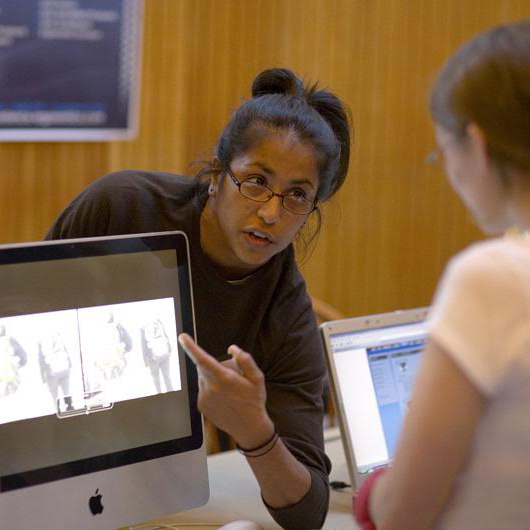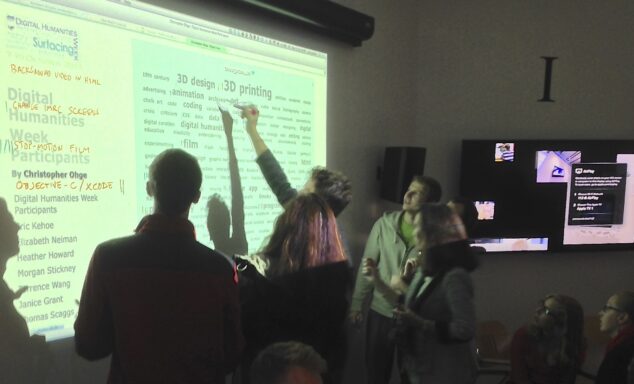Facilities
New Media Labs
Still Water Lab and Focus Ring (127 & 129) are adjoining rooms that have (a) ten iMac stations for photo, audio, and video editing/production; and (b) one or more virtual reality (VR) production workstations. The rooms are staffed 20 hours per week by selected undergraduate senior New Media students (i.e., lab monitors/learning assistants) who help with general training on equipment and software and who check-out and check-in equipment to students enrolled in NMD classes. Adjunct professors are located in Room 131 next door and across the hall who also help and check out equipment.


IMRC
The IMRC Center has a number of prototyping and production facilities, collectively called the IMRC Labs, dedicated to a full range of both digital and analog production technologies. These include the Fabrication Studio, the Prototyping Studio, the Electronics Lab, and the CNC Production lab.
These spaces give users of the IMRC a full range of tools and work spaces needed for a range of work in prototyping, physical production, electronics production, interactive technologies, wearables, Intermedia, digital product design, multiples, textiles and fabric design, digital printing and just about anything else you can think of using physical materials, digital out put technologies, craft processes and/or electronics.
- Fabrication facilities include:
- Makerbot and Z Corp 3D printers
- Universal and Logilase laser cutters/engravers
- Tormach CNC Mill
- Vacuum former.
- Comprehensive shop environment.
SCIS Labs
New Media shared labs with the School of Computing and Information Science (SCIS)
The General Computing Lab Room 138 has (a) five group-work tables with at least one large external monitor in each bank of tables; and (b) one group of three Windows 10 computers. It also has whiteboards and an overhead projector for group work. It is staffed 20 hours per week by selected undergraduate senior computer science students (i.e., lab monitors/learning assistants) who help with general training on equipment as well as tutor on computing and math problems when course teaching assistants (TAs) are unavailable. Several computer science TAs have office hours next door in Room 138A.
Student breakout room 138 has free coffee, water, hot chocolate, a microwave, a refrigerator, etc. It serves also as a group work room. It has whiteboards as well as a large external monitor for mirroring laptops as needed. This room also has lockers containing Arduino kits, mini-drones, robots, and similar items that may be checked out from the Room 138 Lab Monitors. Occasional instructor-led and student-led help or review sessions are scheduled in this room over the other available rooms if possible. For larger groups, Room 138 may be similarly scheduled.

Other Labs
Additional School of Computing and Information Science (SCIS) specialized labs
Other professors in the School support labs used by both computer science undergraduate students and students from multiple disciplines. Among these professors with specialized computing labs include Silvia Nittel (Geosensor Lab, Rm 321 Boardman), Torsten Hahmann (Spatial Knowledge and Artificial Intelligence Lab, Rm 236A Boardman), , and Nimesha Ranasinghe (Multisensory Interactive Media Lab, Rm 237 Boardman). Further, a wide range of undergraduate students including New Media students work in the Virtual Environment and Multimodal Interaction Lab(VEMI), which is located in Carnegie Hall and is supported by SCIS professor Nicholas Giudice. Typically, equipment in specialized research labs is initially supplied through start-up funds and then maintained through external research grants. Additional computer science specialized labs are maintained in East Annex to work with both undergraduate and graduate students, depending on project needs, by several computer science professors: Roy Turner (Maine Software Agents & Artificial Intelligence Lab [MaineSAIL]), Philip Dickens (High Performance Computing Lab), James Fastook (Ice Sheet Modeling Lab), Chawathe (Databases Lab), and Sepideh Ghanavati (Cyber Security Lab). In addition, the student Cyber Security Club with student members from numerous disciplines is provided with a room in the East Annex to support their needs.
Other School-related labs.
Computer science students are highly encouraged to purchase a laptop prior to their second semester in the program that meets minimum specifications outlined by the faculty (see Appendix A of the SCIS Common Use Labs in Boardman Hall Lab Manual.) Consequently, SCIS general-purpose computing labs tend to support the sharing of laptop screens on large lab monitors rather than supplying large numbers of computers in the labs. However, both the School and the University supply computer labs to meet specialized software needs and for those students not required by their programs to obtain laptops. CS faculty teach service courses to meet the needs of other programs on campus in Room 106 Neville Hall, which contains 24 Windows machines.
Campus-wide computing labs.
There are two primary public clusters maintained by the the University of Maine IT department. One is located in the Memorial Student Union (about 25 computers), and one is located in Fogler Library (about 50 machines). Any software used by any course may, upon request, be made available in these clusters, including compilers, office suites, and database software. Both Windows machines and Macintoshes are available. A Collaborative Media Lab (12 Macs) is also located in the library and available to anyone. It provides access to a wide variety of New Media technologies.
Hackerspace, a work space/lab geared toward computing and electronic “makers”, is located in the student union and available for anyone to use. There are two other maker spaces on campus available for use, often for a nominal fee.
Further computing research facilities
Computer science researchers have access to substantial additional computing facilities, including a 648 processor green supercomputer, a 72 processor green supercomputer, five mobile robots, and a teaching/research cybersecurity lab. Also available is access to the University’s computing resources as well as to various supercomputer centers. Access is also available to the Gulf of Maine Observing System which includes an autonomous underwater vehicle and several autonomous boats. The University is an Internet 2 site and has significant high-speed Internet access. Buildings are wired for high-speed Ethernet, and wireless access is available over much of the campus.
